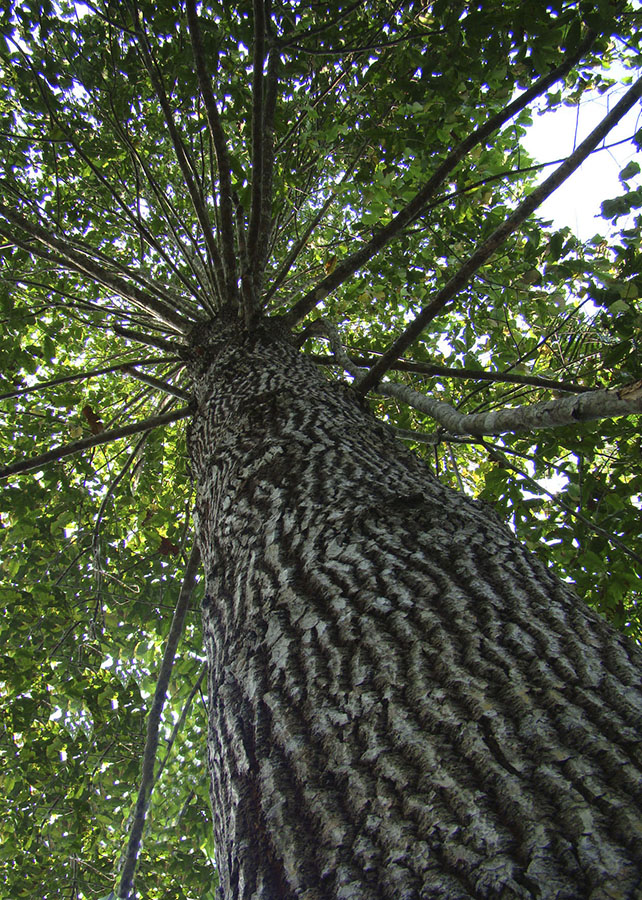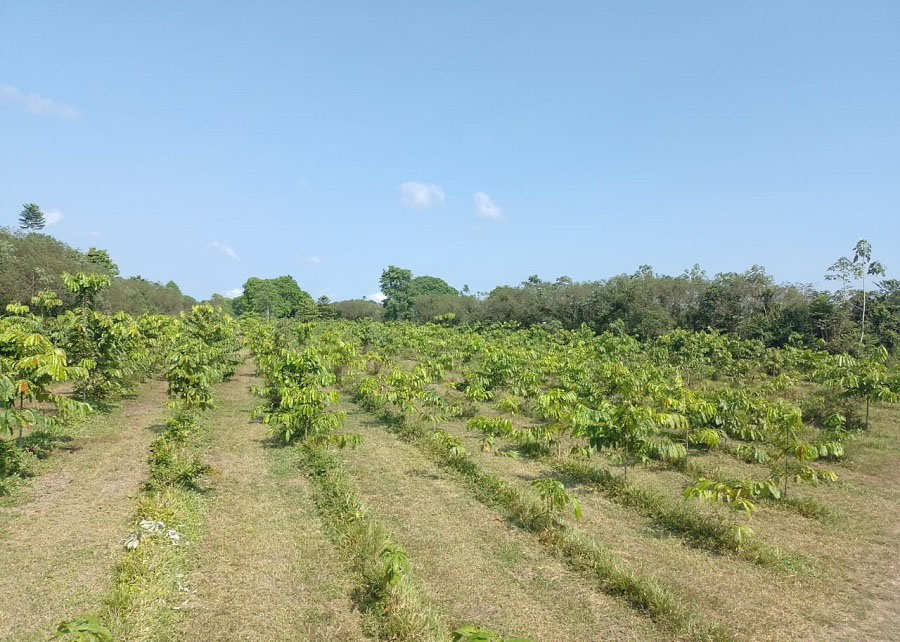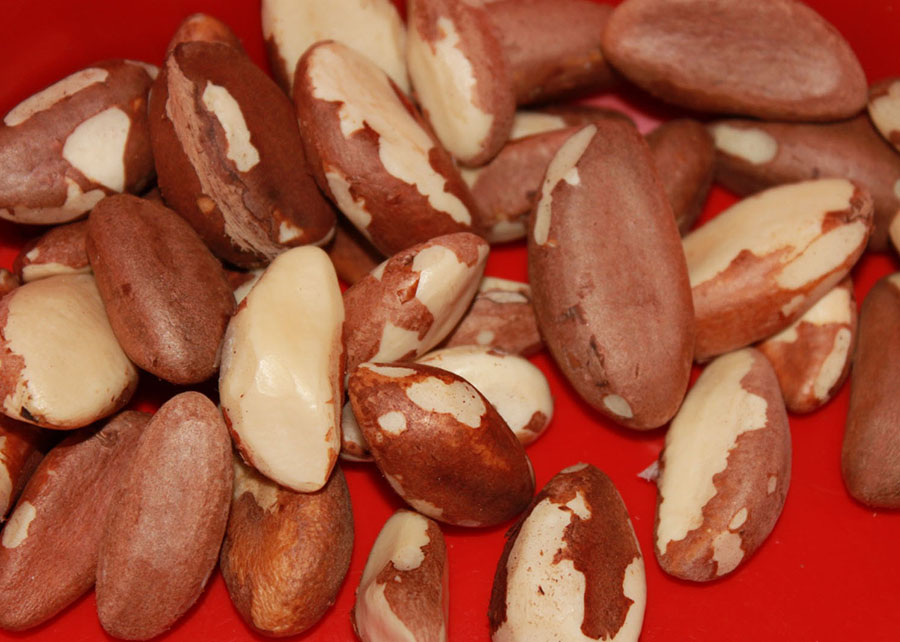The result is very promising to restore forests of the Amazon biome, where there are currently over 5 million hectares of degraded soils. In one of the studied areas, 3,000 hectares of degraded pastures were converted into plantations of Brazil nut trees. Growth capacity in the species demonstrates a physiological strategy that is fully adapted to those types of soils. Research by Embrapa proves a grove has soil recovery capacity that is similar to a natural forest in terms of soil respiration. The application of forestry science in the cultivation of Brazil nut trees helped to reduce seed germination time and to anticipate fruit production time Scientists warn that it is essential to maintain strips of native forest between plantations to favor the presence of pollinators. Embrapa research on Brazil nut (Bertholletia excelsa) plantations indicates that the species is efficient for the recovery of degraded soils in areas where the forest has been removed. This is a very promising result to recompose forests in the Amazon biome, where there are currently over 5 million hectares of soils that need to be restored. Another advantage observed is that Brazil nut trees can produce for over 40 years with little or no nutrient input. In addition to contributing to conservation, the cultivation can help to create jobs and income for forest peoples, as they generate environmental services. The studies are taking place in Brazil nut tree groves cultivated in areas that had previously been degraded pastures in Amazonas state "The growth capacity Brazil nut trees have demonstrated proves that it has a physiological strategy that is fully adapted to those types of soils," asserts the Embrapa Western Amazon researcher Roberval Lima, who conducts forestry studies with the species. The use of Brazil nut trees in the recovery of degraded areas is further backed by studies on emissions from the soil, a process also called soil respiration, which consists in a set of biochemical phenomena involving temperature, humidity, nutrients and oxygen levels that is influenced by natural factors and human action. The studies compared the soil respiration capacity and gas emissions in different ecosystems, according to the land use types in the biome. One of the conclusions is that Brazil nut plantations show levels of soil quality improvement that reveal a tendency to restore its chemical and physical characteristics and the presence of microorganisms. According to the researcher, soils in Brazil nut plantations have 50% higher quality than degraded pasture areas. They held studies comparing the flow of gases from the soil in a natural forest ecosystem, in a post-forest one (after the forest was cleared) and in forestry cultivations such as the Brazil nut groves. "The results indicate that the soil under the planted Brazil nut trees recovers in a way that tends to be close to that of a natural forest," he says. Photo by: Siglia Souza Once a degraded pasture, today the largest Brazil nut plantation in the world One of the places where the study was conducted was the Aruanã Farm, located in the town limits of Itacoatiara, in Amazonas state, where the largest Brazil nut tree plantation in the world is today. With about 1.3 million trees, the planted area of 3,000 hectares within a property of 12,000 hectares replaced a degraded pasture. “The Aruanã Farm project is a good example of how to rehabilitate a degraded area in the Amazon. In the 1970s, some entrepreneurs from São Paulo came to the region with the aim of taking advantage of tax incentives for agricultural projects. Years later, they found that their pastures were degrading. Following technical guidance, they started planting Brazil nuts, also known as Amazon nuts," Lima reports. The researcher has been conducting research at Aruanã Farm since the 1990s, with the purpose of improving forestry management and perfecting a fruit and timber production system. "Today this area has been completely restored with a forest species, generating many benefits from an environmental standpoint, such as soil recovery and fauna attraction, in addition to economic advantages," he observes. Photo by: Roberval Lima Science reduces seed germination time Brazil is the world's largest producer of Brazil nuts, with about 33,000 tons per year, according to data from the Food and Agriculture Organization of the United Nations (FAO), 95% of which comes from forest extraction or foraging. Brazil nuts are a product with growing demand in the world market. However, the current prospect is that in the short term there is no more capacity to expand the production of Brazil nuts from a forest extraction base. According to Lima, the possibility of increasing the domestic production of Brazil nut almonds can occur through plantations, which is much more feasible for workers and actually favors fruit harvesting, since it allows the implementation of groves in more accessible areas and with easier logistics. The contribution of science helped to anticipate the time Brazil nut trees take to bear fruit. The researcher explains that by using the recommended forestry techniques, it is possible to cut the seed germination time from 18 to 6 months. In addition, techniques such as crown grafting and the use of selected early clones can anticipate fruit production. At around 15 years of age, the entire system is already in production with over 80% fructification. “To optimize fructification, an important factor is the issue of pollination,” he adds. Lima warns that it is very important to reserve strips of native forest between the areas where the Brazil nut trees are planted because they favor the presence of pollinators in the environment. At Aruanã Farm, there are 500-meter-large forest strips between the plantations to stimulate the pollination of the Brazil nut trees. Photo bt: Lucio Cavalcanti
Photo: Roberval Lima
![Roberval Lima - The studies are taking place in Brazil nut tree groves cultivated in areas that had previously been degraded pastures in Amazonas state Roberval Lima - The studies are taking place in Brazil nut tree groves cultivated in areas that had previously been degraded pastures in Amazonas state]()
The studies are taking place in Brazil nut tree groves cultivated in areas that had previously been degraded pastures in Amazonas state
Embrapa research on Brazil nut (Bertholletia excelsa) plantations indicates that the species is efficient for the recovery of degraded soils in areas where the forest has been removed. This is a very promising result to recompose forests in the Amazon biome, where there are currently over 5 million hectares of soils that need to be restored. Another advantage observed is that Brazil nut trees can produce for over 40 years with little or no nutrient input. In addition to contributing to conservation, the cultivation can help to create jobs and income for forest peoples, as they generate environmental services.
 The studies are taking place in Brazil nut tree groves cultivated in areas that had previously been degraded pastures in Amazonas state "The growth capacity Brazil nut trees have demonstrated proves that it has a physiological strategy that is fully adapted to those types of soils," asserts the Embrapa Western Amazon researcher Roberval Lima, who conducts forestry studies with the species.
The studies are taking place in Brazil nut tree groves cultivated in areas that had previously been degraded pastures in Amazonas state "The growth capacity Brazil nut trees have demonstrated proves that it has a physiological strategy that is fully adapted to those types of soils," asserts the Embrapa Western Amazon researcher Roberval Lima, who conducts forestry studies with the species.
The use of Brazil nut trees in the recovery of degraded areas is further backed by studies on emissions from the soil, a process also called soil respiration, which consists in a set of biochemical phenomena involving temperature, humidity, nutrients and oxygen levels that is influenced by natural factors and human action. The studies compared the soil respiration capacity and gas emissions in different ecosystems, according to the land use types in the biome.
One of the conclusions is that Brazil nut plantations show levels of soil quality improvement that reveal a tendency to restore its chemical and physical characteristics and the presence of microorganisms.
According to the researcher, soils in Brazil nut plantations have 50% higher quality than degraded pasture areas. They held studies comparing the flow of gases from the soil in a natural forest ecosystem, in a post-forest one (after the forest was cleared) and in forestry cultivations such as the Brazil nut groves. "The results indicate that the soil under the planted Brazil nut trees recovers in a way that tends to be close to that of a natural forest," he says.
Photo by: Siglia Souza
 Once a degraded pasture, today the largest Brazil nut plantation in the world Once a degraded pasture, today the largest Brazil nut plantation in the world
One of the places where the study was conducted was the Aruanã Farm, located in the town limits of Itacoatiara, in Amazonas state, where the largest Brazil nut tree plantation in the world is today. With about 1.3 million trees, the planted area of 3,000 hectares within a property of 12,000 hectares replaced a degraded pasture. “The Aruanã Farm project is a good example of how to rehabilitate a degraded area in the Amazon. In the 1970s, some entrepreneurs from São Paulo came to the region with the aim of taking advantage of tax incentives for agricultural projects. Years later, they found that their pastures were degrading. Following technical guidance, they started planting Brazil nuts, also known as Amazon nuts," Lima reports. The researcher has been conducting research at Aruanã Farm since the 1990s, with the purpose of improving forestry management and perfecting a fruit and timber production system. "Today this area has been completely restored with a forest species, generating many benefits from an environmental standpoint, such as soil recovery and fauna attraction, in addition to economic advantages," he observes. Photo by: Roberval Lima |
 Science reduces seed germination time Science reduces seed germination time
Brazil is the world's largest producer of Brazil nuts, with about 33,000 tons per year, according to data from the Food and Agriculture Organization of the United Nations (FAO), 95% of which comes from forest extraction or foraging. Brazil nuts are a product with growing demand in the world market. However, the current prospect is that in the short term there is no more capacity to expand the production of Brazil nuts from a forest extraction base. According to Lima, the possibility of increasing the domestic production of Brazil nut almonds can occur through plantations, which is much more feasible for workers and actually favors fruit harvesting, since it allows the implementation of groves in more accessible areas and with easier logistics. The contribution of science helped to anticipate the time Brazil nut trees take to bear fruit. The researcher explains that by using the recommended forestry techniques, it is possible to cut the seed germination time from 18 to 6 months. In addition, techniques such as crown grafting and the use of selected early clones can anticipate fruit production. At around 15 years of age, the entire system is already in production with over 80% fructification. “To optimize fructification, an important factor is the issue of pollination,” he adds. Lima warns that it is very important to reserve strips of native forest between the areas where the Brazil nut trees are planted because they favor the presence of pollinators in the environment. At Aruanã Farm, there are 500-meter-large forest strips between the plantations to stimulate the pollination of the Brazil nut trees. Photo bt: Lucio Cavalcanti |
Síglia Souza (MTb 66/AM)
Embrapa Western Amazon
Press inquiries
amazonia-ocidental.imprensa@embrapa.br
Phone number: +55 92 3303-7852
Translation: Mariana Medeiros (13044/DF)
Superintendency of Communications
Further information on the topic
Citizen Attention Service (SAC)
www.embrapa.br/contact-us/sac/

 The studies are taking place in Brazil nut tree groves cultivated in areas that had previously been degraded pastures in Amazonas state "The growth capacity Brazil nut trees have demonstrated proves that it has a physiological strategy that is fully adapted to those types of soils," asserts the Embrapa Western Amazon researcher Roberval Lima, who conducts forestry studies with the species.
The studies are taking place in Brazil nut tree groves cultivated in areas that had previously been degraded pastures in Amazonas state "The growth capacity Brazil nut trees have demonstrated proves that it has a physiological strategy that is fully adapted to those types of soils," asserts the Embrapa Western Amazon researcher Roberval Lima, who conducts forestry studies with the species. 

